The barbell bench press may be one of the most recognized exercises in the fitness sphere. From elite powerlifters like Julius Maddox to your uncle (who swears he put up 405 in high school, man), everyone loves to hit the bench. It is, for good reason, one of the most popular and versatile exercises you can do for increasing your upper body strength or building more muscle. Behold the best — and only — guide you’ll ever need to learn how to bench press like a pro:
Bench Press Video Guide
Multiple-time IPF World Champion Taylor Atwood demonstrates how to do the bench press alongside former BarBend Training Editor, Jake Boly. Check it out here if you’re a visual learner:
[Related: The Best Pre-Workout Supplements for Muscle Gain, Weight Loss, and More]
How To Do the Bench Press
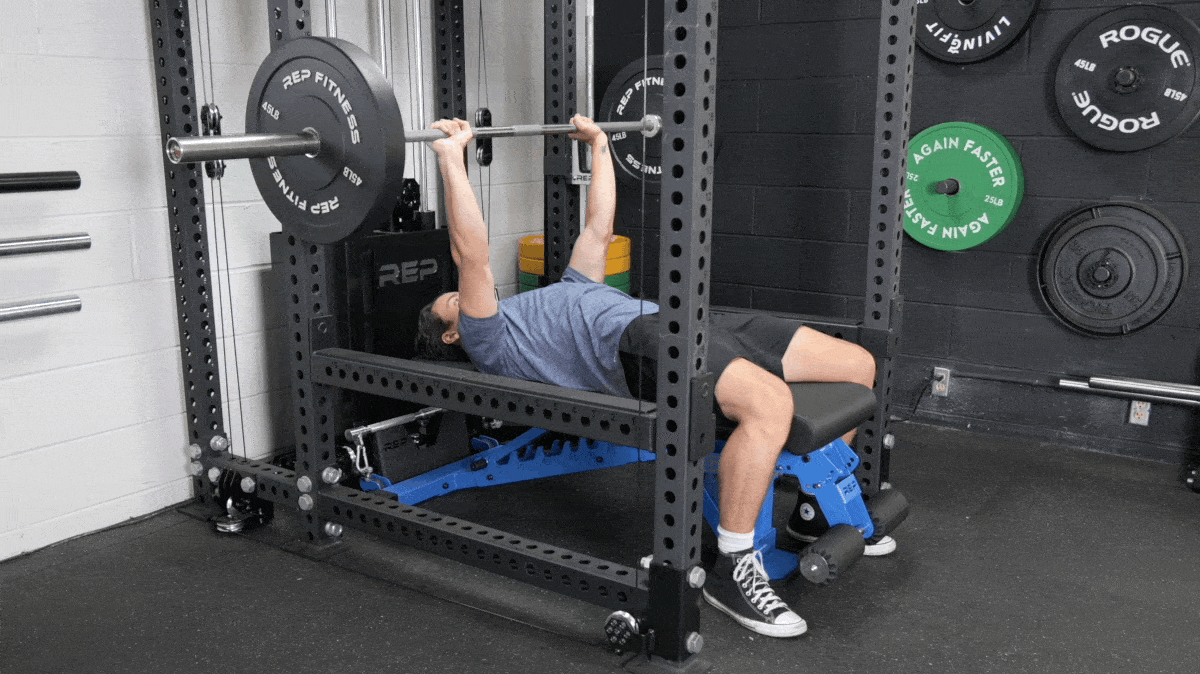
The bench press is for everyone, but certain athletes approach the movement differently. If you’re a bodybuilder or just hitting the gym to get in better shape, the steps below should serve you nicely. But if you’re an aspiring strength athlete, you may want to refer to a more powerlifting-specific bench press guide.
- Step 1: Start by firmly planting your feet on the floor with your knees bent. Arch your back and ensure that your buttocks and upper back are firmly in contact against the bench. Make sure that your scapulas are pinched together and compressed.
- Step 2: Establish full-body tension by inhaling deeply and actively pressing your feet into the floor. The barbell should be roughly over your eyes. From here, hold your breath and “pull” the bar out of the rack such that it ends up directly over your shoulders.
- Step 3: With the barbell directly over your shoulders, break at the elbows and lower it down toward your chest. The point of contact depends on your anatomy and grip width — if you have short arms or a close grip, you’ll generally make contact with the bar lower on your chest.
- Step 4: Once the barbell touches your chest, pause briefly and aggressively drive it back to the starting position. The barbell should move up and back towards your head, so your shoulders, elbows, and wrists are all aligned vertically.
Bench Press Variations
Below are several barbell pressing movements you can implement to increase your overall pressing strength, address mobility or technique limitations, or just build more mass overall.
Incline Bench Press

Why Do It: The incline barbell bench press targets slightly different muscles than the standard flat bench. By adjusting your bench press form slightly and working on an inclined surface, you’ll involve your triceps and front deltoids to a greater degree. You’ll also shift emphasis from your pecs as a whole to your upper chest specifically.
Equipment Needed: Most gyms have a dedicated incline bench press station, but to perform the exercise you can also roll an adjustable weight bench into a squat rack.
- Set the bench seat between a 20- and 40-degree incline.
- Grab the bar with the same grip you’d use on the flat bench press.
- Then, unrack the barbell and lower it toward your chest as far as possible.
Modifications: The higher the angle of the bench, the more difficult the exercise becomes because load shifts almost entirely onto your shoulders. You may also struggle to press comfortably from a high incline if you aren’t used to it.
Pin Press
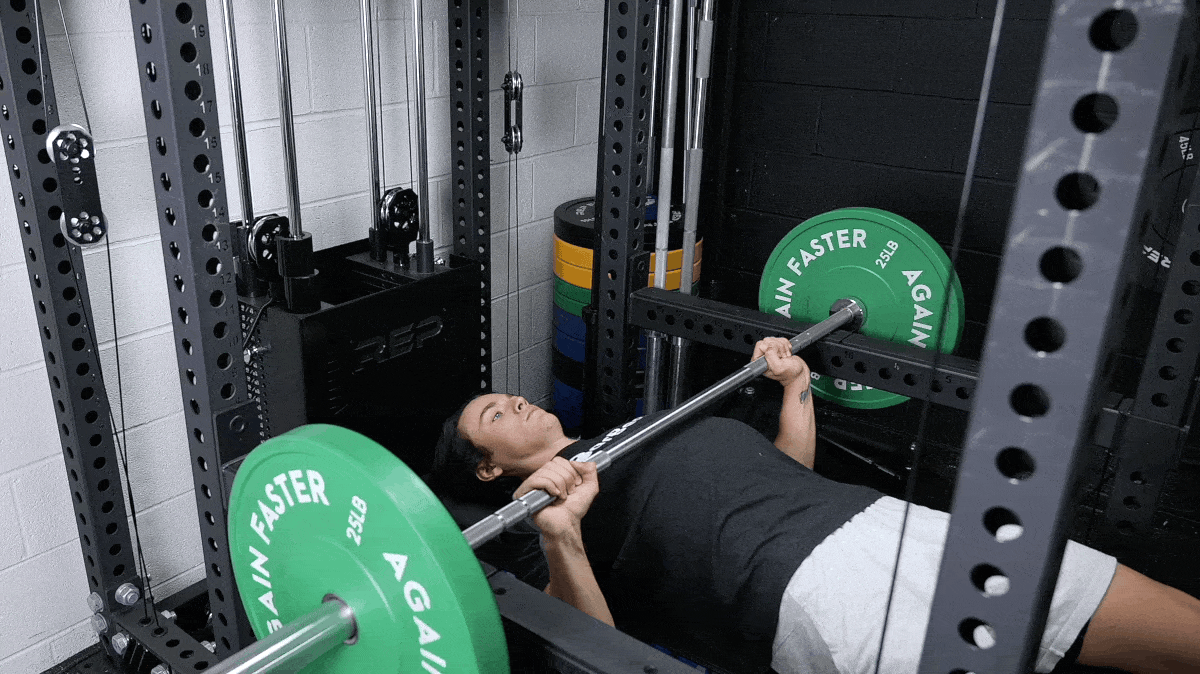
Why Do It: The pin press is a popular bench press accessory exercise because it allows you to safely overload the top half of the range of motion. By situating the bar to rest at a common sticking point, you can load up with heavier weights and work on your explosive power.
Equipment Needed: To perform pin presses, you’ll need a squat or power rack with adjustable safeties as shown above.
- Get yourself situated within a power rack and adjust the safeties such that the bar can rest on them a few inches above your chest.
- Then, bench as you normally would, lowering the bar down onto the safeties in a controlled manner.
Modifications: You can also use the pin press as a modified bench press if you aren’t comfortable touching your chest to the bar yet. Set the pins or safeties to your desired height and press as usual.
Barbell Floor Press
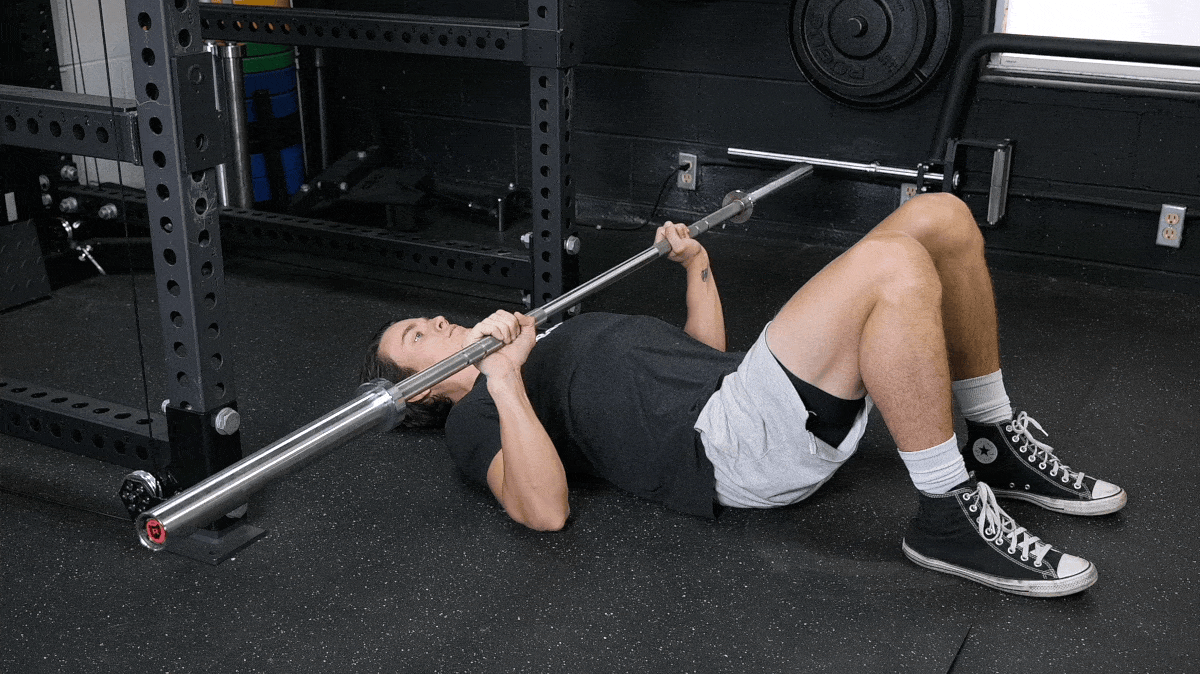
Why Do It: The floor press serves mostly the same purpose as the pin press; it constrains your range of motion. Floor presses let you continue to bench while avoiding a potentially painful range of motion, which can help you work around an injury if necessary. By restricting the press to only the top half, you double-down on the triceps stimulation and take some load off of your pecs.
Equipment Needed: The best way to perform floor presses is to set a barbell into the adjustable hooks of a squat stand or power rack.
- Set a barbell up in a squat or power rack a few feet off the ground. (You can also perform floor presses with a pair of dumbbells as shown in the GIF above.)
- Lie on the floor with your eyes underneath the barbell and unrack it with your standard bench press grip.
- From there, lower the bar or dumbbells down slowly until you feel the backs of your arms touch the floor.
Modifications: Floor presses themselves are a great beginner modification of the bench press. Do this one to build comfort and confidence with the barbell before moving on to the full bench press.
Bench Press Alternatives
Below are two bench press variations that do not include a barbell, which can increase unilateral strength and hypertrophy or add variety to your workout program.
Dumbbell Bench Press
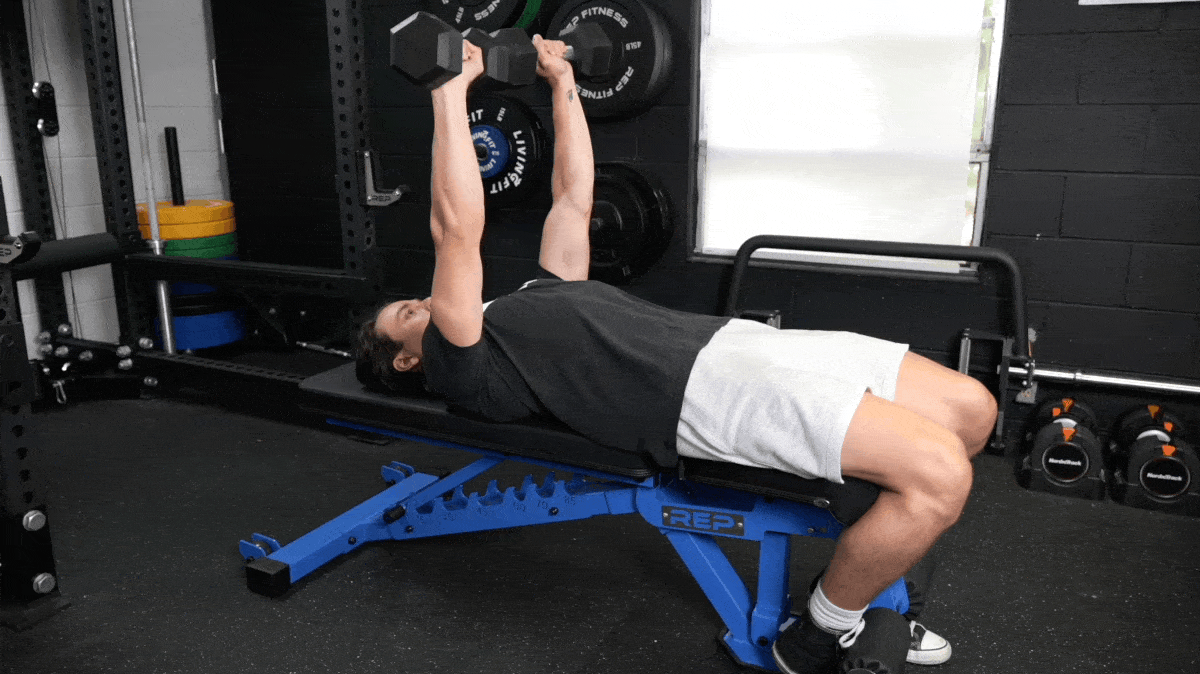
Why Do It: The dumbbell bench press trains the same muscles through the same range of motion as the barbell version, but requires you to control two separate weights instead of one. This increases the stability demand of the exercise and allows you to identify any potential imbalances in strength between your arms.
Equipment Needed: You’ll, of course, need a pair of dumbbells for this variation. You’ll also want a flat bench.
- Grab a pair of dumbbells and sit on the end of a weight bench.
- Then, in one swift but controlled motion, rock back onto the bench and bring the weights up to arm’s length.
- Lower the dumbbells down toward your chest and push them back up again to engage your chest.
Modifications: You can make this move more difficult by placing your feet on the end of the bench rather than on the floor — this will increase the stability demand.
Push-Up

Why Do It: The basic push-up is the bedrock of most upper-body pressing exercises, including the bench press. This movement is mostly for beginners, but there are plenty of ways to modify the push-up so it continues providing value to your strength over time.
Equipment Needed: All you’ll need for the standard push-up is some open space to work. You may consider using an exercise mat as well.
- Get down into a straight-armed plank position.
- Bend at the elbows and slowly lower yourself until your chest comes within a few inches of the floor.
Modifications: To make push-ups easier, try doing the incline variation or perform them while resting on your knees rather than with straight legs. Conversely, you can make the move harder by doing decline push-ups with your feet elevated, or by laying a weight plate across your upper back.
Bench Press Tips
You may be lying down on a weight bench, but don’t go thinking the bench press is both easy to learn and easy to master. Sure, you can lift and lower the bar and make some gains along the way. But, to maximize your results, employ these tactical tips during your next workout:
Nail Your Setup
A good bench press setup is half the battle and starts with your feet, not with your hands. Think of everything other than your arms as the foundation that supports your power. Your feet should be firmly and actively pushed into the floor. You should have a solid, visible arch in your spine, that protects your scapula — which should be retracted.

[Read More: Types of Bench Press Grips — Benefits and How to Use Them]
Inhale before unracking the bar and center it over your shoulders before descending. Hit these beats and every set should be as smooth as butter.
Use a Spotter
When performing any compound, multi-joint free weight exercise, you should employ the assistance of a spotter in the gym — especially if you’re going for a new 1-rep max. This is doubly true for the bench press. Not only can a failed repetition put you in, possibly, a life-or-death situation, but a spotter can help you set up before you lift.
With your shoulders pinned back and your torso locked tight, it can be awkward to unrack a heavy bar from the bench press station. A spotter can provide you with a “lift-off,” helping you unrack the bar and guide it into the starting position without expending too much energy along the way.
Common Bench Press Mistakes
Whether you’re new to the gym overall or just haven’t dabbled in the art of bench pressing, you should be aware of what can go wrong when you lift. The bench press looks simple at a glance — and there are certainly more challenging movements out there — but there’s still plenty that can go wrong.
Not Touching Your Chest
Barring an anatomical limitation or injury, you should probably touch your chest with the bar when you bench. More range of motion is generally better than less, but plenty of newbies stop short out of fear or a lack of confidence with the bar. Play with your posture and grip until you find a setup that allows you to comfortably bring the bar all the way down.
Bouncing the Bar
At the other end of the spectrum from cutting your reps short, you have the dreaded bench bounce. Athletes who can’t control their tempo with the bar, or who have too much of an ego, may find themselves slamming the bar against their sternum to help lift it.
[Read More: The Most Common Bench Press Form Mistakes]
Not only will this lead to some painful bruising on your body, but exploiting the momentum of a severe bounce is likely to rob you of the stimulus from the movement that creates gains in the first place.
Lifting Without a Spotter
There’s absolutely no shame in having someone watch your back while you lift. The bench press can be perilous if things go wrong, so if you’re lifting heavy, you should probably have a spotter present. A good spotter can provide both security and the motivation to help you lift as well as you can.
Who Should Do the Bench Press
The bench press is a versatile movement that can be done with barbells, dumbbells, and even some specialty bars to increase upper body strength, muscle hypertrophy, and sport-specific performance.
If you’re stuck wondering whether the exercise is appropriate for your goals, the answer is probably a resounding “yes.” Still, read on to find out why.
Bodybuilders
Every aspiring physique athlete needs at least a couple of exercises that stay in their repertoire year-round. Many bodybuilders make the bench press a cornerstone of their chest exercises, and for good reason.
You can tweak, tailor, and modify the bench press in a multitude of different ways so it provides you with the most effective stimulus possible for creating quality muscle growth.
Strength Athletes
If you’re a powerlifter, you have nothing short of a contractual obligation to bench press regularly. After all, it’s one of the three events you’re tested on at every competition.
Strongman and weightlifting enthusiasts both have a few reasons to dabble with benching as well, even if the lift isn’t a training requisite. For strongmen, benching with a barbell can be a nice reprieve from working with the log or axle bar and can provide some welcome variation to training.
[Read More: Ways to Improve Your Bench Press Without Weights]
Weightlifters do most of their pressing from a standing position, but you can still include a bit of bench work here and there as part of your accessory routine.
Functional Fitness Athletes
Whether you’re a CrossFit ride-or-die or just enjoy partaking in functional training overall, you need strong pressing muscles. The bench press may not feature in many practical, real-world workouts, but the pressing strength you gain from the bench will undeniably carry over into other tasks like push-ups or tire flips.
Regular Gymgoers
You don’t need to have competitive aspirations to make use of the bench press. If you go to the gym for personal fulfillment or just to live a healthier, more active lifestyle, the bench press merits inclusion in your exercise plan due to its simplicity and accessibility. Anyone can bench — and bench well — and reap the benefits.
How To Add The Bench Press Into Your Workout Routine
Generally speaking, you should perform the bench press early into your training session if you’re concerned with how to increase your bench press numbers or build more muscle. That said, the specific sets and reps you’ll use depend on what your goals are:
- To Gain Muscle: Start with four to six sets of six to 10 repetitions with moderate loads.
- To Gain Strength: Perform anywhere between three to six sets of one to five repetitions.
- To Improve Muscular Endurance: Hit two to three sets on the bench press with as many as 20 repetitions and light weights.
Benefits of the Bench Press
A big lift begets big gains. Below are some of the undeniable benefits of the bench press you can expect to attain if you dedicate yourself to becoming a proficient presser.
Muscular Hypertrophy
The bench press is a potent upper body mass-building exercise that stresses some of the body’s largest muscles. Since it’s a compound movement, involving multiple joints acting at once, the bench recruits huge portions of your overall musculature.
Your pectorals, triceps, front deltoids, and even your upper back all get plenty of love on each and every rep of the bench press.
Upper Body Strength
You need to feed all of your fundamental movement patterns a proper diet of the right exercises to get truly strong. The bench press is fantastic for developing upper body strength simply because it demands so much of both your muscular and nervous systems.
[Read More: The Only Bench Press Warm-Up You’ll Ever Need]
The exercise is bilateral, meaning it involves both of your arms at once, which enables you to work with much heavier weights than if you were to use dumbbells or a machine. Compound, bilateral, and a high loading potential is the recipe for successful strength gains.
Convenience
The high level of muscular engagement also makes the bench press a fantastic choice if you’re short on time in the gym. If you’re only able to get in one or two upper-body lifts per session, you need something that targets several muscles at once and allows you to lift heavy.
[Read More: How to Increase Your Bench Press — Tips and Programs to Try]
The bench press is comprehensive in terms of stimulation and convenient to boot — all you need is an open station and you’re good to go.
Muscles Worked by the Bench Press
The bench press builds your chest, but there’s a lot more at play than just pulverizing your pecs. Here are all of the muscles that are involved every time you unrack your barbell, ordered by their biomechanical importance:
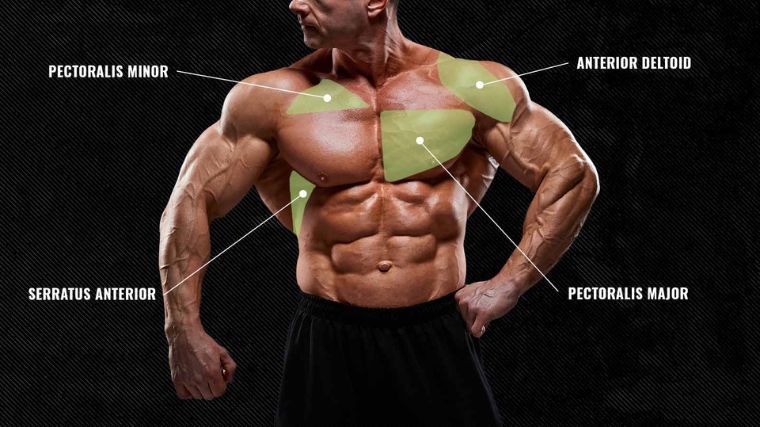
Pectoralis Major (and Minor)
The pectoral muscles are the prime mover in the bench press and are targeted to varying in all bench press variations. Factors that can influence the demands placed on the pecs during the bench include grip width, eccentric control, and the range of motion you use.
Triceps
The triceps are responsible for elbow extension and are the primary assistance muscle for the pecs in the bench press. You can increase loading demands on the triceps during the bench press by moving your grip width inward, but your triceps still get plenty of love no matter how you set up the bench.
Anterior Deltoids
The front head of your shoulder helps your pecs out every time you bench. The biomechanical motion of bench pressing is called shoulder flexion, a movement that your anterior deltoid is heavily responsible for. It’s common for beginner lifters to feel more tension in their shoulders than their chest before they properly “connect” with the bench press.
Upper Back
Although it doesn’t physically move the weight, the muscles that make up your upper back provide a critical base of support to press off of. Furthermore, the scapular pinch, a critical technique for all barbell benching, is created via isometric tension from your middle traps and rhomboids.
You need a strong and stable upper back if you want to build up your bench press — period.
Frequently Asked Questions
What is the bench press good for?
Most folks use the bench press as a way to develop upper body strength. The bench press works your chest, shoulders, and arms simultaneously, so it’s also a great exercise to develop muscle mass.
How much should you bench press?
As a multi-joint compound exercise, you have the potential to lift heavy weights in the bench press if you’re so inclined. However, you aren’t obligated to do so. Your bench press sets should be challenging, but not too heavy that you can’t maintain good form.
How much can an average person bench press?
Strength varies tremendously between individuals. Don’t get too hung up comparing your strength to someone else.
That said, if you dedicate yourself to resistance training, you should be able to bench your own body’s weight within a couple of years.
Featured Image: Maksim Toome/Shutterstock